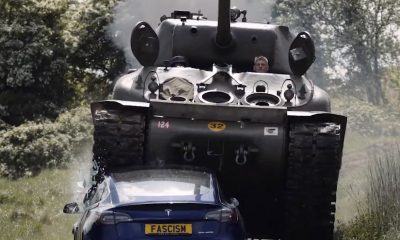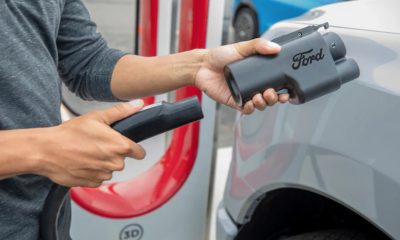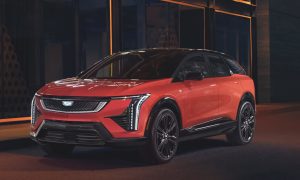Now that Ford has started delivering the Performance variant of the Mustang Mach-E all-electric crossover, the GT configuration is heading to the drag strip to test its mettle in the all-too-common proving ground for performance vehicles.
On the heels of taking delivery of their own Mach-E GT in mid-August, Ford Mach-E Forum member 0t60-3.5 hit the Cedar Falls Motorsports Park in Cedar Falls, Iowa. The all-electric Mach-E ran a 12.657-second 1/4-mile at 100.02 miles per hour, according to a receipt given to the owner at the track. Impressive, to say the least, the Mach-E GT undoubtedly is living up to the name of its Mustang predecessors. However, this time the powertrain was fueled by electricity and not by gasoline, making it a sustainable and eco-friendly performance run.
Credit: 0t60-3.5 | Mach E Forum
The vehicle was not in Ford’s advertised “Track Mode,” which actually is called “Unbridled Mode.” Ford described it as “an exhilarating drive experience that pays homage to the legacy of Mustang sound in a unique package designed for an all-new electric vehicle.” This may have limited its performance slightly, but that is speculative. Additionally, the car was charged at 72%, and its tire pressure was slightly high at 42 PSI. Ford recommends it to be at 39.
Splits for the Mach-E were as follows:
- 1/4-mile: 12.657 seconds @ 100.02 MPH
- 1,000 feet: 10.433 seconds
- 1/8-mile: 8.03 seconds @ 86.67 MPH
- 330 feet: 5.26 seconds
- 60 feet: 1.99 seconds
Additionally, Dragy, a speed tracking device, found the following acceleration rates:
- 0-10 MPH in .58s
- 0-20 MPH in 1.20s
- 0-30 MPH in 1.80s
- 0-40 MPH in 2.44
- 0-50 MPH in 3.21
- 0-60 MPH in 4.12
- 0-60 MPH with 1-foot rollout in 3.89

Credit: 0t60-3.5 | Mach E Forum
Electric cars have a comparative advantage over their gas-powered opposition, especially during 1/4-mile drags. The lack of energy transfer from the motor to the transmission in an EV, which is present in a combustion engine vehicle, allows an electric car to take off significantly quicker than a gas car. This is where EVs have a substantial competitive advantage, and it shows. While the Mach-E certainly did not run the fastest 1/4-mile drag ever, it certainly did a good job, even with limited battery power and being Ford’s first electric car. This could be utilized as a benchmark for future models.
The Tesla Model S Plaid still has the record, and it doesn’t appear that Ford will dethrone the all-electric flagship sedan from Tesla anytime soon. However, there is plenty to build on, especially as Ford was not necessarily focused on high-end, record-breaking performance for the Mach-E. However, the vehicle still performed reasonably well, and there is plenty to be proud of moving forward.
Check out 0t60-3.5’s video below.
What do you think? Let us know in the comments below, or be sure to email me at [email protected] or on Twitter @KlenderJoey.
Elon Musk
USDOT Secretary visits Tesla Giga Texas, hints at national autonomous vehicle standards
The Transportation Secretary also toured the factory’s production lines and spoke with CEO Elon Musk.

United States Department of Transportation (USDOT) Secretary Sean Duffy recently visited Tesla’s Gigafactory Texas complex, where he toured the factory’s production lines and spoke with CEO Elon Musk. In a video posted following his Giga Texas visit, Duffy noted that he believes there should be a national standard for autonomous vehicles in the United States.
Duffy’s Giga Texas Visit
As could be seen in videos of his Giga Texas visit, the Transportation Secretary seemed to appreciate the work Tesla has been doing to put the United States in the forefront of innovation. “Tesla is one of the many companies helping our country reach new heights. USDOT will be right there all the way to make sure Americans stay safe,” Duffy wrote in a post on X.
He also praised Tesla for its autonomous vehicle program, highlighting that “We need American companies to keep innovating so we can outcompete the rest of the world.”
National Standard
While speaking with Tesla CEO Elon Musk, the Transportation Secretary stated that other autonomous ride-hailing companies have been lobbying for a national standard for self-driving cars. Musk shared the sentiment, stating that “It’d be wonderful for the United States to have a national set of rules for autonomous driving as opposed to 50 independent sets of rules on a state-by-state rules basis.”
Duffy agreed with the CEO’s point, stating that, “You can’t have 50 different rules for 50 different states. You need one standard.” He also noted that the Transportation Department has asked autonomous vehicle companies to submit data. By doing so, the USDOT could develop a standard for the entire United States, allowing self-driving cars to operate in a manner that is natural and safe.
News
Tesla posts Optimus’ most impressive video demonstration yet
The humanoid robot was able to complete all the tasks through a single neural network.

When Elon Musk spoke with CNBC’s David Faber in an interview at Giga Texas, he reiterated the idea that Optimus will be one of Tesla’s biggest products. Seemingly to highlight the CEO’s point, the official Tesla Optimus account on social media platform X shared what could very well be the most impressive demonstration of the humanoid robot’s capabilities to date.
Optimus’ Newest Demonstration
In its recent video demonstration, the Tesla Optimus team featured the humanoid robot performing a variety of tasks. These include household chores such as throwing the trash, using a broom and a vacuum cleaner, tearing a paper towel, stirring a pot of food, opening a cabinet, and closing a curtain, among others. The video also featured Optimus picking up a Model X fore link and placing it on a dolly.
What was most notable in the Tesla Optimus team’s demonstration was the fact that the humanoid robot was able to complete all the tasks through a single neural network. The robot’s actions were also learned directly from Optimus being fed data from first-person videos of humans performing similar tasks. This system should pave the way for Optimus to learn and refine new skills quickly and reliably.
Tesla VP for Optimus Shares Insight
In a follow-up post on X, Tesla Vice President of Optimus (Tesla Bot) Milan Kovac stated that one of the team’s goals is to have Optimus learn straight from internet videos of humans performing tasks, including footage captured in third person or by random cameras.
“We recently had a significant breakthrough along that journey, and can now transfer a big chunk of the learning directly from human videos to the bots (1st person views for now). This allows us to bootstrap new tasks much faster compared to teleoperated bot data alone (heavier operationally).
“Many new skills are emerging through this process, are called for via natural language (voice/text), and are run by a single neural network on the bot (multi-tasking). Next: expand to 3rd person video transfer (aka random internet), and push reliability via self-play (RL) in the real-, and/or synthetic- (sim / world models) world,” Kovac wrote in his post on X.
News
Starship Flight 9 nears as SpaceX’s Starbase becomes a Texan City
SpaceX’s launch site is officially incorporated as Starbase, TX. Starship Flight 9 could launch on May 27, 2025.

SpaceX’s Starbase is officially incorporated as a city in Texas, aligning with preparations for Starship Flight 9. The newly formed city in Cameron County serves as the heart of SpaceX’s Starship program.
Starbase City spans 1.5 square miles, encompassing SpaceX’s launch facility and company-owned land. A near-unanimous vote by residents, who were mostly SpaceX employees, led to its incorporation. SpaceX’s Vice President of Test and Launch, Bobby Peden, was elected mayor of Starbase. The new Texas city also has two SpaceX employees as commissioners. All Starbase officials will serve two-year terms unless extended to four by voters.
As the new city takes shape, SpaceX is preparing for the Starship Flight 9 launch, which is tentatively scheduled for May 27, 2025, at 6:30 PM CDT from Starbase, Texas.
SpaceX secured Federal Aviation Administration (FAA) approval for up to 25 annual Starship and Super Heavy launches from the site. However, the FAA emphasized that “there are other licensing requirements still to be completed,” including policy, safety, and environmental reviews.
On May 15, the FAA noted SpaceX updated its launch license for Flight 9, but added: “SpaceX may not launch until the FAA either closes the Starship Flight 8 mishap investigation or makes a return to flight determination. The FAA is reviewing the mishap report SpaceX submitted on May 14.”
Proposed Texas legislation could empower Starbase officials to close local highways and restrict Boca Chica Beach access during launches. Cameron County Judge Eddie Trevino, Jr., opposes the Texas legislation, insisting beach access remain under county control. This tension highlights the balance between SpaceX’s ambitions and local interests.
Starbase’s incorporation strengthens SpaceX’s operational base as it gears up for Starship Flight 9, a critical step in its mission to revolutionize space travel. With growing infrastructure and regulatory hurdles in focus, Starbase is poised to become a cornerstone of SpaceX’s vision, blending community development with cutting-edge aerospace innovation.
-

 News2 weeks ago
News2 weeks agoTesla Cybertruck Range Extender gets canceled
-

 Elon Musk6 days ago
Elon Musk6 days agoTesla seems to have fixed one of Full Self-Driving’s most annoying features
-

 Lifestyle2 weeks ago
Lifestyle2 weeks agoAnti-Elon Musk group crushes Tesla Model 3 with Sherman tank–with unexpected results
-

 News2 weeks ago
News2 weeks agoStarlink to launch on United Airlines planes by May 15
-

 News2 weeks ago
News2 weeks agoTesla Semi gets new adoptee in latest sighting
-

 News2 weeks ago
News2 weeks agoTesla launches its most inexpensive trim of new Model Y
-

 News2 weeks ago
News2 weeks agoUS’ base Tesla Model Y has an edge vs Shanghai and Berlin’s entry-level Model Ys
-

 News2 weeks ago
News2 weeks agoTesla Cybertruck owners get amazing year-long freebie





















